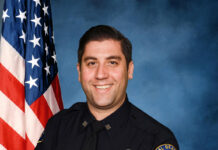Raymond Biel, a resident of Leisure World’s Mutual 14, is one of the last surviving members of the 509th Composite Group, an Army Air Force unit that dropped the atomic bomb. Biel, 88, recently spoke about his role in the bombing of Hiroshima, Japan at a meeting of the Paramount Rotary Club.
This wasn’t the first time Biel shared his experience. Every year, he addresses high school students about the events of Aug. 6, 1945. He recently shared the experience again with the Sun Newspapers.
Biel flew in the Full House, one of three “ships” that served as weather planes the morning of the bombing. “I was a co-pilot,” he said.
Biel was born Sept. 3, 1922. In 1943, he joined the Air Force. He was trained in Holland, Michigan and went through flight school. He expected to go to Europe. He did not expect to become part of what he called the top secret of World War II.
Biel was one of 15 men pulled out of a pool of candidates and sent to Paramount, Neb., to train on B-29 planes. These planes were straight from the factory, stripped down to minimize their weight. The planes had no armor.
Col. Paul Tibbets, the man who commanded the bombing operation against Hiroshima, needed crews and Biel was in one of the crews.
He and the others were trained in high altitude bombing and navigation.
In 1945, the 509th Composite Group was formed. It was made up of 15 crews and seven transport planes.
In all, 1,700 men were involved.
“We trained dropping what they called ‘fat man’ bombs, determining trajectory,” Biel said.
Biel didn’t know it at the time, but the atomic bombs that would eventually be dropped on Hiroshima and Nagasaki were called Little Boy and Fat Man. Little Boy was the first atomic bomb to be put into active service during a war.
The men in the 509th Composite Group did not know they were working with an atomic bomb. Biel said they had good food, good airplanes and good crews.
“We had top priority in the Air Force,” he said.
Anyone who said anything about the ultra-secret operation was immediate dismissed—so no one talked.
Biel said most people today don’t realize how large an operation the Manhattan Project—the program to develop the atomic bomb—actually was. Biel estimated that President Franklin Delano Roosevelt secretly spent $2 billion on the project. He said even Congress did not know about the project.
As for Biel and his crew, they flew five missions dropping fat man bombs from the Full House.
Biel pointed at a model of the Enola Gay, the B-29 that actually delivered the atomic bomb, and pointed at two bomb bays on the underside. The forward bomb bay housed the weapon. The second bomb bay was used to store extra fuel. The planes needed the extra fuel. On the day of the mission, the planes spent 13 hours in the air traveling from the small island of Tinian to the target cities.
The “ships,” as Biel called the airplanes, were named by the enlisted men. Officers had nothing to do with naming the planes. The Full House was decorated with an illustration of a Japanese soldier being literally kicked out of an outhouse.
According to the Department of Energy Web site, “Alternatives to dropping the atomic bomb on a Japanese city were many, but few military or political planners thought they would bring about the desired outcome, at least not quickly.”
U.S. officials apparently discussed warning the Japanese about the bomb. The idea was rejected. Warning the Japanese might give them a chance to stop the plane. American POWs might be moved to a target city. And what if the bomb turned out to be a dud?
The decision to use the bomb was made. Japan would not be warned.
Biel and his crew got up at 1:30 a.m. the morning of Aug. 6, 1945. They were told they would not be carrying a bombardier. They would instead carry a meteorologist.
The Full House and two other B-29s would be weather planes. Each ship would fly over a target city and radio back a weather report. The weather planes were about one hour ahead of the Enola Gay. A ship was standing by in Iwo Jima, in case someone had to abort.
When Biel talks in public about the flight, people sometimes ask if there was a bathroom aboard the Full House. He said there was a bucket. The first person to use it had to clean it.
That said, Biel said it was a comfortable flight, despite the 13-hour length. It was a large plane with plenty of room to walk around. The plane had to be large: Little Boy weighed 10,000 pounds, was 10 feet long and was 3 feet in diameter.
The flight was comfortable in another sense: The Full House flew 40,000 feet above the ground. Japan did not have any planes that could reach that high. The crews had little reason to fear being shot out of the sky. Biel said you were removed from what was happening on the ground.
No one in the 509th Composite Group knew what the bombs would do.
The Full House flew over Nagasaki, which would be bombed three days later. The weather was clear over all three cities. The decision was made to bomb the primary target: Hiroshima.
Biel said 80,000 people were killed—most of them cremated instantly by the blast. The shockwave caused a fireball. He said the bomb destroyed about a third of the city.
The Department of Energy Web site estimated that 70,000 people were killed in the immediate blast and by the end of 1945 radiation sickness had brought the casualty figure closer to 100,000.
Biel said the one bomb caused more damage than 300 B-29 planes had caused during the firebombing of Tokyo a month earlier.
“We didn’t know it was an atomic weapon until President Truman came on the radio that afternoon,” he said.
Biel said that the man who was supposed to photograph the bombing forgot to remove the lens cap from the camera.
Biel is proud of his role in that pivotal event of the 20th Century. Like many historians—though not all of them—Biel believes more lives were saved than lost.
Biel said Japan had 12,000 planes ready to attack any sea-going vessel that approached the nation. Biel said there could have been as many as two million casualties if the United States and allied nations had invaded by land. He said when the atomic bomb fell, fighting men stationed in the Pacific cheered—because they would not have to fight.
The Department of Energy Web site said that while many historians agree with Biel, others do not. Some believe Japan would have surrendered without as much bloodshed as was predicted. Those historians believe the atomic bomb was dropped on Japan to intimidate the Soviet Union.
Japan surrendered after the second atomic bomb was dropped on Nagasaki on Aug. 9, 1945.
Biel flew back to the United States in October. He landed in Roswell, New Mexico, took his discharge and used the GI Bill to enter dental school He practiced dentistry in Bellflower for 28 years. He served for 10 years on the Paramount Unified School Board. He and his current wife attend the Emmanuel Church in Paramount every Sunday. Biel moved into Leisure World when he married Tressa Biel seven years ago.
The 509th Composite Group holds an annual reunion. Biel said 750 people attended the 50th anniversary reunion. Only two vets attended the last reunion. The atomic veterans are just about all gone. “I’m the only one of our crew that’s still living,” he said.












